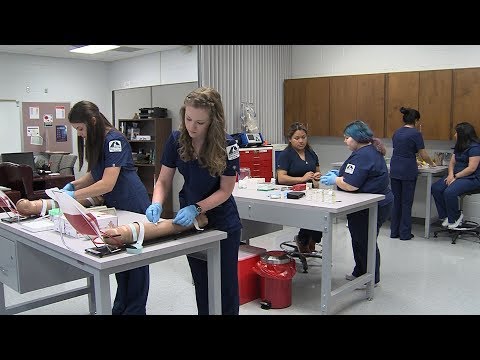How to Become a Medical Assistant
Contents
- Introduction: What is a medical assistant and what do they do?
- The educational requirements for becoming a medical assistant.
- The skills needed to be a successful medical assistant.
- The different roles and responsibilities of a medical assistant.
- The different working environments for medical assistants.
- The different job opportunities available for medical assistants.
- The salary and benefits of being a medical assistant.
- The career outlook for medical assistants.
- 10 tips for becoming a successful medical assistant.
- FAQs about becoming a medical assistant.
Considering a career as a medical assistant? Here’s everything you need to know about how to become a medical assistant from education requirements to job outlook.
Checkout this video:
Introduction: What is a medical assistant and what do they do?
A medical assistant is a person who performs administrative and certain clinical tasks in a medical office. Their duties may vary depending on state law and the particular medical office where they work. They typically work in physician’s offices, hospitals, clinics, and other healthcare facilities.
Most Medical assistants have postsecondary education such as a certificate or diploma from a medical assisting program. Some states require certification for certain tasks, such as taking X-rays. In addition to formal education, most medical assistants also receive on-the-job training from a supervising physician or another medical assistant.
The educational requirements for becoming a medical assistant.
Medical assistants are in high demand and the job outlook is excellent. If you’re thinking of becoming a medical assistant, you’re probably wondering what the educational requirements are.
The good news is that you don’t need a four-year degree to become a medical assistant. Most programs can be completed in about a year, and some schools offer evening and weekend classes to accommodate students who work full-time.
While there are no formal educational requirements, most employers prefer to hire candidates who have completed an accredited program. Accredited programs are available at many community colleges, vocational schools, and technical institutes.
Most accredited programs include both classroom and clinical instruction. Classroom instruction covers topics such as anatomy, physiology, Medical Terminology pharmacology, and medical office procedures. Clinical instruction provides students with the opportunity to gain hands-on experience in a real-world medical setting.
Upon completion of an accredited program, students will be awarded a certificate or diploma. Some programs also offer an associate’s degree in medical assisting, although this is not required for entry-level positions.
If you’re interested in becoming a medical assistant, the first step is to research accredited programs near you. Once you’ve found a few programs that meet your needs, contact the admissions office to learn more about the admissions process and what you need to do to get started.
The skills needed to be a successful medical assistant.
In order to be a successful medical assistant, there are a few essential skills you will need to possess. Below is a list of key skills, along with a brief description of each.
-Interpersonal skills: Medical assistants must be able to effectively communicate with patients, as well as maintain a professional and compassionate bedside manner.
-Organizational skills: Medical assistants must be able to keep track of patients’ medical records appointments, and test results. They must also be able to effectively communicate this information to the rest of the medical staff.
-Attention to detail: Medical assistants must be able to accurately take down patients’ information and follow instructions from doctors and nurses.
-Physical stamina: Medical assistants may be required to lift and move patients, as well as stand for long periods of time.
The different roles and responsibilities of a medical assistant.
Medical assistants are vital members of the healthcare team. They are trained to perform both clinical and administrative tasks in a medical office setting. Clinical duties may include taking and recording patient medical histories, performing basic laboratory tests, assisting with patient examinations, and giving injections. Administrative duties may include scheduling appointments, maintaining Medical records billing insurance companies, and handling correspondence.
Medical assistants must be able to work well under pressure, be detail oriented, and have good communication skills. They must also be able to handle the stress of dealing with sick patients on a daily basis. Most medical assistants have at least a high school diploma, although some have completed postsecondary training programs.
The different working environments for medical assistants.
While some medical assistants work in primary care offices, others work in hospitals or other inpatient facilities. Some may even assist with outpatient surgeries or duties at a nursing home. A medical assistant’s working hours can also vary depending on their place of employment. For example, those who work in a hospital may be required to work nights, weekends, and holidays, while those who work in a primary care office may have more regular daytime hours.
The different job opportunities available for medical assistants.
Medical assistants are multi-skilled health professionals who perform a wide range of duties in clinics, hospitals, and other healthcare facilities. They play a vital role in the healthcare team by providing support to doctors and other medical staff.
There are many different job opportunities available for medical assistants. Some work in general medical offices, while others specialize in areas such as pediatrics, obstetrics, or surgery. Some medical assistants work in hospitals, while others work in clinics or private practices.
The duties of a medical assistant vary depending on their specialty and the type of facility they work in. However, there are some common tasks that all medical assistants perform. These include taking patient histories, recording vital signs, scheduling appointments, assisting with procedures, and handling lab specimens.
If you are interested in becoming a medical assistant, there are a few things you need to do. First, you need to complete an accredited medical assistant program. Once you have completed your training, you will need to pass the Certified Medical Assistant (CMA) exam administered by the American Association of Medical Assistants (AAMA). Once you have passed this exam, you will be able to use the CMA credential after your name.
The salary and benefits of being a medical assistant.
In addition to a fulfilling career helping others, medical assistants enjoy many other advantages. Perhaps most importantly, medical assisting is a well-paying profession. According to the Bureau of Labor Statistics, the median salary for medical assistants in 2017 was $32,480 per year, or $15.60 per hour. Experienced medical assistants can earn significantly more than that. The top 10 percent of earners made more than $46,630 per year, while the bottom 10 percent made less than $23,650.
The career outlook for medical assistants.
The career outlook for medical assistants is promising. According to the Bureau of Labor Statistics, employment of medical assistants is expected to grow 19 percent from 2018 to 2028, much faster than the average for all occupations. This growth is due in large part to the increasing number of aging baby boomers who will need more medical care as they age.
10 tips for becoming a successful medical assistant.
The medical assistant profession is one of the fastest-growing in the United States If you’re considering a career in this field, here are 10 tips to help you become a successful medical assistant:
1. Get a formal medical education. You can do this by completing an accredited certificate, diploma or degree program.
2. Become certified. Although it’s not always required, becoming certified through organizations like the American Association of Medical Assistants (AAMA) can give you a competitive edge in the job market.
3. Develop strong communication skills. As a medical assistant, you’ll be interacting with patients on a daily basis. It’s important that you have excellent communication skills and are able to put people at ease.
4. Stay organized. One of the key duties of a medical assistant is keeping the office organized and running smoothly. This includes everything from scheduling appointments to maintaining patient records.
5. Be detail-oriented. Another important aspect of the job is paying close attention to detail. This is especially important when taking down patients’ medical histories and performing administrative tasks such as billing and coding insurance forms correctly.
6 . Possess strong computer skills . In today’s technology-driven world, it’s essential that medical assistants have strong computer skills . Many of their day-to-day tasks will involve using computers , so it’s important that they feel comfortable using them .
7 . Be able to multitask . Medical assistants often have to juggle several tasks at once , so it ’s important that they be able to multitask and stay calm under pressure .
8 . Have knowledge of basic medical procedures . Although they are not expected to perform complex medical procedures , it is helpful ifmedical assistants have some knowledge of basic procedures , such as taking vital signs or giving injections .
9 . Be compassionate . One of the most important qualities a successful medical assistant can possess is compassion . This profession requires individuals to interact with patients who may be experiencing illnesses , injuries or other health problems , so it ’s important that they be able to show empathy and understanding .
10 . Enjoy working with people . Medical assistants need to enjoy working with patients as well as other members of the healthcare team , such as nurses , doctors and pharmacists
FAQs about becoming a medical assistant.
Q: What does a medical assistant do?
A: Medical assistants perform a variety of administrative and clinical tasks to support the work of physicians and other health professionals. They might take medical histories, help patients onto examination tables, give injections, prepare laboratory specimens, and SCHEDULE PATIENT APPOINTMENTS.
Q: How much does a medical assistant make?
A: According to the Bureau of Labor Statistics, the median annual salary for medical assistants was $32,480 in 2016.
Q: How do I become a medical assistant?
A: You can become a medical assistant by completing an accredited medical assisting program. These programs typically last one to two years and lead to a certificate or associate degree.







